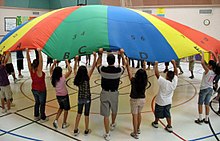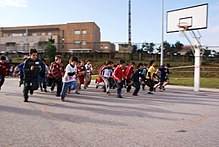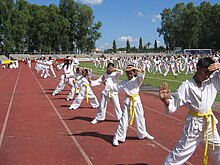|
Physical education  Physical education, often abbreviated to Phys. Ed. or PE, and sometimes informally referred to as gym class or simply just gym, is a subject taught in schools around the world. PE is taught during primary and secondary education and encourages psychomotor, cognitive, and effective learning through physical activity and movement exploration to promote health and physical fitness.[1] When taught correctly and in a positive manner, children and teens can receive a storm of health benefits. These include reduced metabolic disease risk, improved cardiorespiratory fitness, and better mental health.[2] In addition, PE classes can produce positive effects on students' behavior and academic performance.[3] Research has shown that there is a positive correlation between brain development and exercising.[4] Researchers in 2007 found a profound gain in English Arts standardized test scores among students who had 56 hours of physical education in a year, compared to those who had 28 hours of physical education a year.[5] Many physical education programs also include health education as part of the curriculum. Health education is the teaching of information on the prevention, control, and treatment of diseases.[6] Curriculum in physical educationA highly effective physical education program aims to develop physical literacy through the acquisition of skills, knowledge, physical fitness, and confidence.[7] Physical education curricula promote healthy development of children, encourage interest in physical activity and sport, improve learning of health and physical education concepts, and accommodate for differences in student populations to ensure that every child receives health benefits.[8] These core principles are implemented through sport participation, sports skill development, knowledge of physical fitness and health, as well as mental health and social adaptation.[8] Physical education curriculum at the secondary level includes a variety of team and individual sports, as well as leisure activities. Some examples of physical activities include basketball, soccer, volleyball, track and field, badminton, tennis, walking, cycling, and swimming.[9] Chess is another activity that is included in the PE curriculum in some parts of the world. Chess helps students to develop their cognitive thinking skills and improves focus, while also teaching about sportsmanship and fair play.[9] Gymnastics and wrestling activities offer additional opportunities for students to improve the different areas of physical fitness including flexibility, strength, aerobic endurance, balance, and coordination.[9] Additional activities in PE include football, netball, hockey, rounders, cricket, four square, racing, and numerous other children's games. Physical education also teaches nutrition, healthy habits, and individuality of needs.[10] Pedagogy The main goals in teaching modern physical education are:[11]
It is critical for physical educators to foster and strengthen developing motor skills and to provide children and teens with a basic skill set that builds their movement repertoire, which allows students to engage in various forms of games, sports, and other physical activities throughout their lifetime.[12] These goals can be achieved in a variety of ways. National, state, and local guidelines often dictate which standards must be taught in regards to physical education. These standards determine what content is covered, the qualifications educators must meet, and the textbooks and materials which must be used. These various standards include teaching sports education, or the use of sports as exercise; fitness education, relating to overall health and fitness; and movement education, which deals with movement in a non-sport context.[12] These approaches and curricula are based on pioneers in PE, namely, Francois Delsarte, Liselott Diem, and Rudolf von Laban, who, in the 1800s focused on using a child's ability to use their body for self-expression. This, in combination with approaches in the 1960s, (which featured the use of the body, spatial awareness, effort, and relationships) gave birth to the modern teaching of physical education.[13] Recent research has also explored the role of physical education for moral development in support of social inclusion and social justice agendas,[14] where it is under-researched, especially in the context of disability, and the social inclusion of disabled people.[15] Technology use in physical educationMany physical education classes utilize technology to assist their pupils in effective exercise. One of the most affordable and popular tools is a simple video recorder. With this, students record themselves, and, upon playback, can see mistakes they are making in activities like throwing or swinging.[16] Studies show that students find this more effective than having someone try to explain what they are doing wrong, and then trying to correct it.[16] Educators may also use technology such as pedometers and heart rate monitors to make step and heart rate goals for students.[17][18][19] Implementing pedometers in physical education can improve physical activity participation, motivation and enjoyment.[20] Other technologies that can be used in a physical education setting include video projectors and GPS systems. Gaming systems and their associated games, such as the Kinect, Wii, and Wii Fit can also be used. Projectors are used to show students proper form or how to play certain games. GPS systems can be used to get students active in an outdoor setting, and active exergames[clarification needed] can be used by teachers to show students a good way to stay fit in and out of a classroom setting.[21] Exergames, or digital games that require the use of physical movement to participate, can be used as a tool to encourage physical activity and health in young children.[22] Technology integration can increase student motivation and engagement in the Physical Education setting.[23] However, the ability of educators to effectively use technology in the classroom is reliant on a teacher's perceived competence in their ability to integrate technology into the curriculum.[23] Beyond traditional tools, recent AI advancements are introducing new methods for personalizing physical education, especially for adolescents. AI applications like adaptive coaching are starting to show promise in enhancing student motivation and program effectiveness in physical education settings.[24] By locationAccording to the World Health Organization (WHO), it is suggested that young children should be participating in 60-minutes of exercise per day at least 3 times per week in order to maintain a healthy body.[25] This 60-minute recommendation can be achieved by completing different forms of physical activity, including participation in physical education programs at school.[26] A majority of children around the world participate in Physical Education programs in general education settings.[27] According to data collected from a worldwide survey, 79% of countries require legal implementation of PE in school programming.[27] Physical education programming can vary all over the world. AsiaPhilippinesIn the Philippines, P.E. is mandatory for all years in school, unless the school gives the option for a student to do the Leaving Certificate Vocational Programme instead for their fifth and sixth year. Some schools have integrated martial arts training into their physical education curriculum.[28][29][30][31][32] SingaporeA Biennial compulsory fitness exam, NAPFA, is conducted in every school to assess pupils' physical fitness in Singapore.[33] This includes a series of fitness tests. Students are graded by a system of gold, silver, bronze, or as a fail. NAPFA for pre-enlistees serves as an indicator for an additional two months in the country's compulsory national service training if they attain bronze or fail. Europe IrelandIn Ireland, one is expected to do two semesters worth of 80-minute PE classes. This also includes showering and changing times. So, on average, classes are composed of 60–65 minutes of activity.[34] PolandIn Poland, pupils are expected to do at least three hours of PE a week during primary and secondary education.[35] Universities must also organise at least 60 hours of physical education classes in undergraduate courses.[36][clarification needed] SwedenIn Sweden, the time school students spend in P.E. lessons per week varies between municipalities, but generally, years 0 to 2 have 55 minutes of PE a week; years 3 to 6 have 110 minutes a week, and years 7 to 9 have 220 minutes. In upper secondary school, all national programs have an obligatory course, containing 100 points of PE, which corresponds to 90–100 hours of PE during the course (one point per hour). Schools can regulate these hours as they like[how?] during the three years of school students attend. Most schools have students take part in this course during the first year and offer a follow-up course, which also contains 100 points/hours.[37] United Kingdom
In England, pupils in years 7, 8, and 9 are expected to do two hours of exercise per week. Pupils in years 10 and 11 are expected to do one hour of exercise per week.[38] In Wales, pupils are expected to do two hours of PE a week.[39] In Scotland, Scottish pupils are expected to have at least two hours of PE per week during primary and lower secondary education. In Northern Ireland, pupils are expected to participate in at least two hours of physical education (PE) per week during years 8 to 10. PE remains part of the curriculum for years 11 and 12, though the time allocated may vary. North AmericaLeft: A U.S. high school girls' water polo team (with their male coaches in background) posing with their trophy. Right: A U.S. university girl practising a difficult gymnastics maneuver. CanadaIn British Columbia, the government has mandated in the grade one curriculum that students must participate in physical activity daily five times a week. The educator is also responsible for planning Daily Physical Activity (DPA), which is thirty minutes of mild to moderate physical activity a day (not including curriculum physical education classes). The curriculum also requires students in grade one to be knowledgeable about healthy living. For example, they must be able to describe the benefits of regular exercise, identify healthy choices in activities, and describe the importance of choosing healthy food.[40][better source needed] Ontario, Canada has a similar procedure in place. On October 6, 2005, the Ontario Ministry of Education (OME) implemented a DPA policy in elementary schools, for those in grades 1 through 8. The government also requires that all students in grades 1 through 8, including those with special needs, be provided with opportunities to participate in a minimum of twenty minutes of sustained, moderate to vigorous physical activity each school day during instructional time.[41] United StatesThe 2012 "Shape Of The Nation Report" by the National Association for Sport and Physical Education (part of SHAPE America) and the American Heart Association found that while nearly 75% of states require physical education in elementary through high school, over half of the states permit students to substitute other activities for their required physical education credit, or otherwise fail to mandate a specific amount of instructional time. According to the report, only six states (Illinois, Hawaii, Massachusetts, Mississippi, New York, and Vermont) require physical education at every grade level.[42] A majority of states[quantify] in 2016 did not require a specific amount of instructional time, and more than half allow exemptions or substitution. These loopholes can lead to reduced effectiveness of the physical education programs.[43] Zero Hour is a before-school physical education class first implemented by Naperville Central High School. In the state of Illinois, this program is known as Learning Readiness P.E. (LRPE). The program was based on research indicating that students who are physically fit are more academically alert, experience growth in brain cells, and enhancement in brain development. NCHS pairs a P.E. class that incorporates cardiovascular exercise, core strength training, cross-lateral movements, as well as literacy and math strategies which enhance learning and improve achievement.[44] See alsoReferences
External links
|

